Embracing the Light: An Interview with Artist James Burns
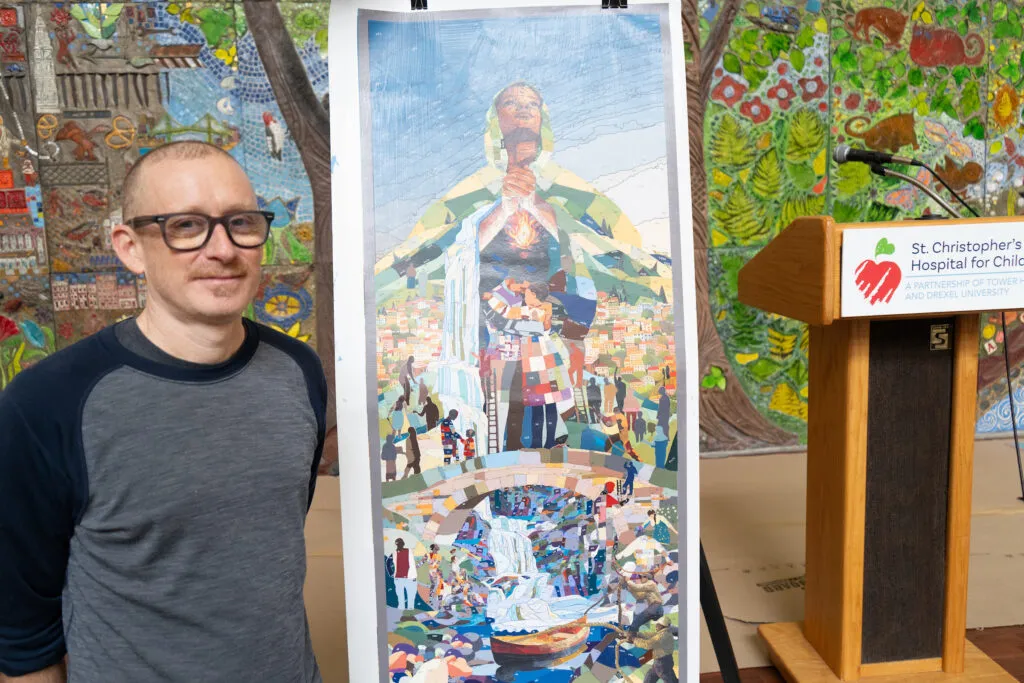
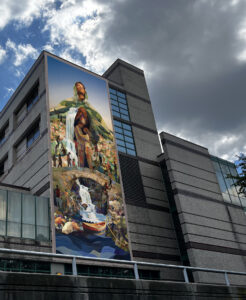
While there are a myriad of philosophies and spiritual beliefs regarding the value and sacredness of a single life, almost all may agree that its unique sparkle and composition are like no other in comparison.
In other words, there is only one fearfully and wonderfully made “you”.
But what happens when hardships, pain and the cares of this world seem to drive us or those we love into a corner—only to suffer in silence?
September is Suicide Awareness and Prevention Month, a prime time to raise awareness, to bring hope, healing and comfort to those who have been impacted by suicide, as well as a time to spark meaningful conversations and dialogue surrounding the importance of mental health.
If you or someone you love may be struggling with suicidal thoughts, please dial or text 988, the National Suicide Hotline where there is help available for 24 hours a day, and 7 days a week, with specialists who speak both English and Spanish. You are not alone.
That is precisely what Mural Arts’ Porch Light partners alongside Philadelphia-based muralist James Burns are doing in their recent initiative, Embracing the Light, a collaborative, community-driven mural project. The dedication is free and open to the public, and will take place on Wednesday, September 24, 2025, from 11 am to 1 pm at St. Christopher’s Hospital for Children, 160 E Erie Avenue, Philadelphia, PA 19134. For more information, please visit the event page here.
Artist James Daniel Burns has been working in and with communities in Philadelphia for over 20 years. Originally a teacher with the Archdiocese and the Philadelphia School District, James blends his talents as a working artist and his experience working with people to create collaborative community-based murals. Cultivating a participatory practice that engages community members throughout the various stages of creating, James utilizes an approach that prioritizes listening and experimentation to land at works born of the communal voice. Read on to hear what he has to say in this exclusive interview surrounding Embracing the Light.
What was it like to engage the community for Embracing the Light, especially surrounding such poignant themes of loss, resilience, and hope from various perspectives?
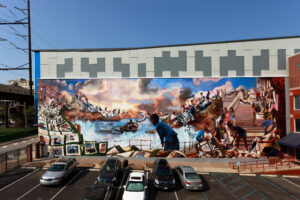
I’ll start by saying that it has been a robust community effort that spans many years, beginning with Finding the Light Within in 2011. Engaging with these two projects, and the individuals who make this work special, has been, surprisingly, one of the most rewarding experiences of my life. Also, one of the most challenging, It has opened my eyes to the issue of mental health and suicide as one of the biggest social and political challenges that we face here in the U.S. Each story shared, each loss felt. The survivors who are left to grieve, or rebuild after an attempt, have come together here to be a part of something visible and tangible that gives shape to pain, grief and loss, and still providing hope and understanding. I think all involved understand that it is a club that no one wants to be a part of, but it is a convergence where I have witnessed the best examples of communal resilience and support.
Can you speak more about the impact of community engagement and the arts in terms of mental wellness?
I can, from my own perspective, but it’s really amazing how the community members I have worked with have responded to this. I think this question is more for the community. I am a part of it, but I’m pretty entrenched in the process.
But, personally, I feel that art, and community engagement are powerful vehicles, particularly when used together. Art breaks down barriers, it’s pure, and it nurtures the soul. When you can focus on that work in a way that highlights any topic, you can remove some of the stigma that exists around a particular conversation by addressing it through that lens. Mental health, as a talking point, is rife with stigma. Over the last 10-12 years, the public dialogue has moved in the right direction. Still, I remember Barbera Swanson’s video on YouTube, where she talked about the stigma of the “mental health” conversation, and how it often immediately goes toward a focus on deficits, so I like how you posed the question. I believe that practicing art, being creative, and inspired are acts that can nourish the spirit. I believe the communal creative process fosters connection and understanding, whether it is a mural, a play, or a movie. How that can impact individual mental wellness really has a lot to do with the intention. In this case, our intent with this process and this artwork is to publicly recognize this issue and remind people that they are not alone in their loss or their struggle, and there is help available. In this case, I think art is the vehicle, the mural, the writing workshops, the performance, the community involvement is all “art” and the impact is the community who chooses to engage, and what they carry away with them as participant, or spectator.
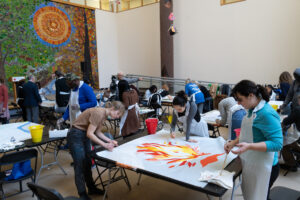
Tell us a bit about your previous mural project, Finding the Light Within, that addressed this issue. What kind of impact did it have? How has it changed you as a person and an artist?
This project was my introduction to a world that I was previously unaware of, and the Project Manager, Cathy Harris, approached this with great sincerity, as I think we both had experienced people close to us with either ideation or loss. Suicide had impacted me on the periphery over the years. My grandfather, whom I had never met, one of my dear friends in elementary school lost his brother when we were all very young, and a college classmate and friend all come to mind immediately.
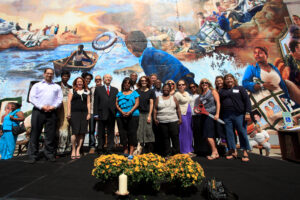
When I was presented with this project, I think my early conversations with Mom about her loss bubbled to the surface. Engaging in Finding the Light Within rounded out my ideas about Suicide and Mental Health in a big way. I am no expert, but my understanding has grown. I tapped into a community that was previously unknown. It was somewhat formal under the A.F.S.P. Philadelphia Chapter, but not limited to it. The DBHIDS Community and several grassroots support groups were also involved. Even the Fire Department of Philadelphia played a big part. I worked with so many folks who were dealing with loss, all at once for me, it was complicated and very emotional, and I questioned a lot about my own threshold for compassion, my ability to navigate these challenging subjects in a personal way with a lot of folks. I did feel like I may have bottomed out or become numb at times, finding my limits, or I may have pushed up against them. But this project was pivotal for me; it helped me grow my understanding of the need for work like this and a deeper appreciation for the more clinical fields and the work they do. Also, it showed me how critical the community is as a player in both individual and communal health. This project shaped my understanding of mental health, and I believe it shaped the work that I did next. The public project I was involved in would build upon the experience of Finding the Light Within, with a greater focus on strategies for achieving mental wellness. For example, the mural “Sanctuary” was part of a city-wide wellness initiative. We focused on reflection strategies, meditation, healthy eating on a budget, smoking cessation, and community connection. Much of the dialogue with the community was rooted in the 8 dimensions of wellness. I believe our Porch Light Program, in partnership with DBHIDS, has effectively advocated for these experiences. As an artist, I’ve been both a student and an ambassador of these learnings.
How have things evolved with this project?
Embracing the Light has evolved along a similar script as Finding the Light Within. But this iteration has felt very different. I felt more settled because I knew more about what we were setting out to do. Both projects had a bit of magic. We (Cathy Harris and I) started with the idea of storytelling, bringing together those who have lost and those who have struggled, and sharing our stories. Those stories were developed into a script, and there was a performance, first at Christ Church in 2012 and then at Fringe Arts in 2024, for the community. And we hosted a series of community paint days at Saint Christopher’s Hospital (Dec 24-March 25) and invited the community to be a part of the production. This is the site of the new mural. We are also working on a memorial of names that will be included at the street level below the mural. That is a bit different than what we delivered with the first project. I’ve had a pretty surreal experience with this.

There is always anxiety with this work for me, but every step of the way, there has been something that has been putting me at ease, and it’s hard to say what it is. The people I have been working with have been so supportive on just about every front. This work is not without challenges, but it’s something about the way things have been clicking. It feels like confidence, but I almost don’t want to say that because I’m afraid something will go wrong. (Smiling) We are still working away. But thus far, things have been falling into place quite well. But I had a friend from when I was younger who recently lost a child. This was after we had completed a significant amount of engagement work with the community. It was surreal to hear this news, and I felt compelled to reach out regarding the memorial as our work with the community was coming to a close. I want her child to be a part of the memorial. I want to offer condolences, but I also want her to be present with others who are on a similar path and know that she is not alone. I know there is comfort there. So, saying that things are going well is kind of strange because in many cases, we are collectively and actively navigating tragedy. So maybe it’s the universe telling me that we are doing something right and setting us up for success. And perhaps that is what I have been feeling. There is something frantic in the work at times that is being offset by an internal calm that I’ve never experienced before. And for me, that is how things have been evolving.
As an artist, what are you hoping that individuals who encounter your work begin to ask themselves?
As an artist, I keep my expectations low and hopes high concerning the audience. I feel like I always have to start with myself as the audience. This mural work, in particular, is a part of a communal process, so the folks who helped shape this are the second audience. We work together to present to a larger audience. All that said, art is an experience, and as someone who practices, I can hope that it arrives in a good way, or at the right time. I value craft, and I hope that there is a question of “what is this, and why was it done?” And that the message in the work is clear enough, or well done enough, that it touches or inspires, or opens something that was previously closed off. And that the message, however it is received, is carried with them out into the world as a kindness, or a light, when needed.
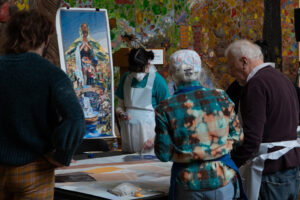
What new visions of healing are you hoping to invoke, both for those who are survivors and those who were impacted by suicide through this project?
Collectively, we discussed optimism in relation to the image. It carries similar themes to the first mural, and there is a dialogue there between the two, as many of the folks involved were also involved in the current project. The quilt, the water, and the boat, collectively embodying something that inspires hope, resilience, and comfort through connection, were some ideas that shaped the visual work. We’ve captured the imagery, and the community makes a powerful statement here. The memorial component is a big part of that. It completes the work. We recognize those we have lost, together, and create a line of communication with a larger public that there is help.
What would you say has been the most rewarding aspect of this project for you?
Just today, I received a thank you for “giving us hope”. If that is true, in any sense, I would say for sure that it is quite a reward.
But there is not one thing. You have to look at the whole of it to really understand. But getting to know some of the folks that I’ve engaged with on a deeper level has been a fantastic experience. Through working with all the individuals involved, hearing their stories, and learning from this collective experience, I am inspired by the resilience, courage, and determination to make a difference and connect with others. And to be able to offer something to the community that is a collective statement in the face of loss is more than rewarding.
To be a part of this showing of resilience brings me joy. I have witnessed throughout my time with both of these projects such strength and vulnerability. One thing that I’ve heard from a few people involved is that this has been an opportunity for their loved ones’ names to be said aloud, and I’m glad that I could be a part of that.
If you or someone you love may be struggling with suicidal thoughts, please dial or text 988, the National Suicide Hotline where there is help available for 24 hours a day, and 7 days a week, with specialists who speak both English and Spanish. You are not alone.
